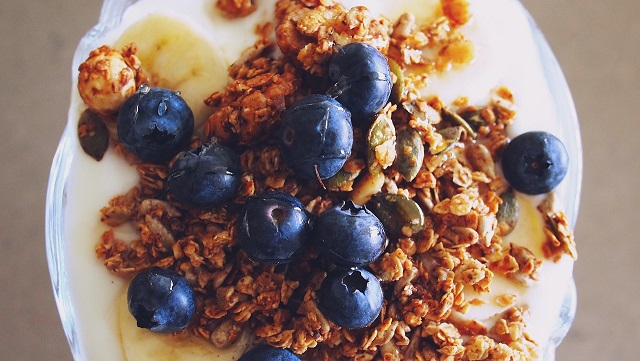Fiber is a type of carbohydrate found in plants. Unlike other nutrients like proteins, carbohydrates, and fats, it is not digested by the enzymes in the human intestines, as such it is not absorbed into the blood stream. Fiber is broadly divided into soluble and insoluble. Soluble fiber dissolves in water forming a viscous gel which practically slows down gastric emptying. Foods with a high content of soluble fiber include oats, beans, lentils, peas, carrots, barley, and apples. Insoluble fiber on the other hand does not dissolve in water, but rather pulls water into the intestines, speeding up the movement of food through the digestive tract. Food rich in insoluble fiber are whole wheat grains, green leafy vegetables, fruits with edible peel or seeds, and nuts (1, 2).
Benefits
- Helps prevent constipation. Insoluble fiber draws water into the intestines, increasing both the bulk and volume of stool. This softens the stool and makes it easier to pass out. Abdominal pain, hemorrhoids (swelling of veins in the anus and lower rectum), anal fissures (skin tear around the anus) and protrusion of rectal tissue outside the anus, are all complications that can arise because of constipation (3).
- Reduces the risk of colon cancer. Dietary fiber increases the bulk of stool, diluting cancer-causing substances (carcinogens) in feces. By increasing bowel movements, it also reduces the contact time between carcinogens and the lining of the colon, significantly reducing the risk of development of colon cancer. Furthermore, it is fermented by bacteria in the colon to produce short chain fatty acids that have been demonstrated to protect the colon against cancer (4).
- Lowers blood cholesterol. Fiber binds to cholesterol molecules and prevents their absorption in the blood stream. This is the reason why the regular consumption of fiber rich foods is associated with lower blood cholesterol levels. A good blood cholesterol level is crucial to prevent the development of atherosclerosis, and heart disease (5).
- Lowers blood sugar levels. Soluble fiber dissolves in water forming a thick gel that slows down the movement of food from the stomach. As such, it slows down the digestion of digestible carbohydrates, resulting in absorption of sugars that occurs at a slower rate that does not cause spikes in the blood (6).
- Helps with weight loss. Fiber rich foods are not calorie dense, hence for the same volume of food, you will consume lesser calories. For example, a serving of 100g of cooked pinto beans only gives 143 calories (7). Besides, the high soluble fiber content of beans and other fiber rich foods will slow down gastric emptying, making you feel fuller for a longer period. This helps you reduce your frequency of eating and ultimately your calorie intake (8).
How to add to your diet (2, 9).
- Eat a variety of fruits, green leafy vegetables, beans, whole grains, whole bran, and nuts.
- Eat the peels and seeds of fruits with edible peels or seeds, as these peels and seeds are loaded with fiber. For example, apples and pears. Go for whole fruits than fruit juices as fruits have a significant amount of fiber removed during processing.
- Replace processed white rice, wheat, corn and other grains with brown rice, whole wheat flour, whole corn, and other whole grains.
- Eat nuts like almonds and cashew instead of processed snacks like crackers or potato chips.
- Manually add fiber rich seeds like flaxseeds and chia seeds to meals during cooking, like soups or stir fries.
Fiber plays an integral part of any healthy diet. The United States Department of Agriculture (USDA) recommends that an adult consume up to 50g a day, with a recommended average consumption of about 25g for women and 38g for men (9). So, eat a variety of fiber rich foods for an ideal coverage.
REFERENCES
- Fiber. (2012, September 18). Retrieved November 25, 2022, from The Nutrition Source website: https://www.hsph.harvard.edu/nutritionsource/carbohydrates/fiber/
- From Mayo Clinic website: https://www.mayoclinic.org/healthy-lifestyle/nutrition-and-healthy-eating/in-depth/fiber/art-20043983
- Constipation. (n.d.). Retrieved November 25, 2022, from Hopkinsmedicine.org website: https://www.hopkinsmedicine.org/health/conditions-and-diseases/constipation
- Masrul, M., & Nindrea, R. D. (2019). Dietary fibre protective against colorectal cancer patients in Asia: A meta-analysis. Open Access Macedonian Journal of Medical Sciences, 7(10), 1723–1727. doi:10.3889/oamjms.2019.265
- Soliman, G. A. (2019). Dietary fiber, atherosclerosis, and cardiovascular disease. Nutrients, 11(5), 1155. doi:10.3390/nu11051155
- CDC. (2022, July 27). Fiber: The carb that helps you manage diabetes. Retrieved November 25, 2022, from Centers for Disease Control and Prevention website: https://www.cdc.gov/diabetes/library/features/role-of-fiber.html
- FoodData central. (n.d.-u). Retrieved November 25, 2022, from Usda.gov website: https://fdc.nal.usda.gov/fdc-app.html#/food-details/175200/nutrients
- Salleh, S. N., Fairus, A. A. H., Zahary, M. N., Bhaskar Raj, N., & Mhd Jalil, A. M. (2019). Unravelling the effects of soluble dietary fibre supplementation on energy intake and perceived satiety in healthy adults: Evidence from systematic review and meta-analysis of randomised-Controlled Trials. Foods (Basel, Switzerland), 8(1), 15. doi:10.3390/foods8010015
- McManus, K. D. (2019, February 27). Should I be eating more fiber? Retrieved November 25, 2022, from Harvard Health website: https://www.health.harvard.edu/blog/should-i-be-eating-more-fiber-2019022115927
